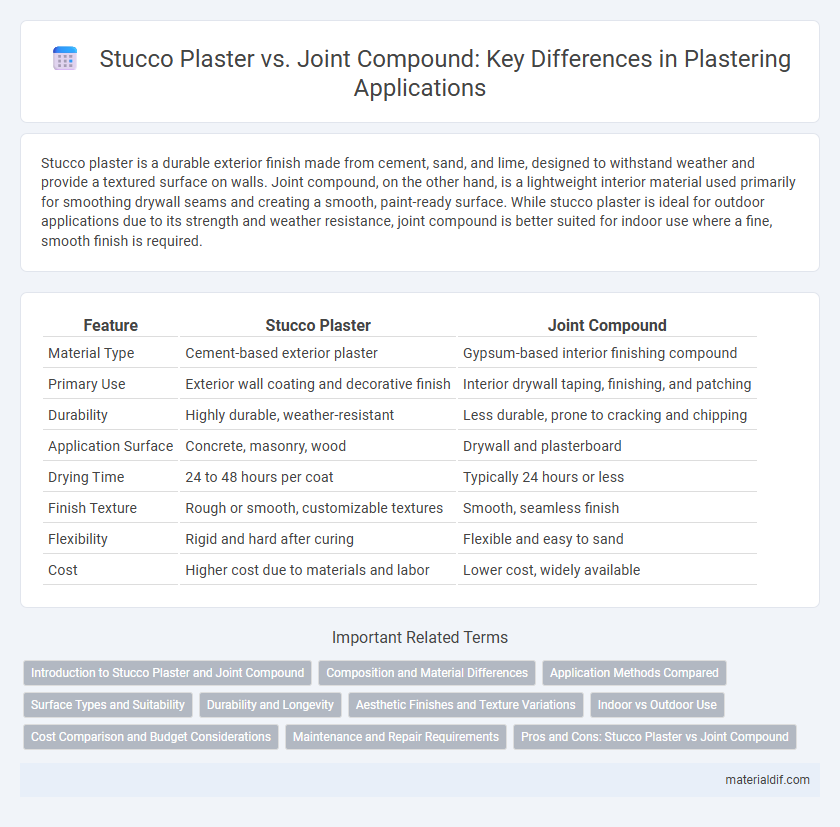Stucco plaster is a durable exterior finish made from cement, sand, and lime, designed to withstand weather and provide a textured surface on walls. Joint compound, on the other hand, is a lightweight interior material used primarily for smoothing drywall seams and creating a smooth, paint-ready surface. While stucco plaster is ideal for outdoor applications due to its strength and weather resistance, joint compound is better suited for indoor use where a fine, smooth finish is required.
Table of Comparison
| Feature | Stucco Plaster | Joint Compound |
|---|---|---|
| Material Type | Cement-based exterior plaster | Gypsum-based interior finishing compound |
| Primary Use | Exterior wall coating and decorative finish | Interior drywall taping, finishing, and patching |
| Durability | Highly durable, weather-resistant | Less durable, prone to cracking and chipping |
| Application Surface | Concrete, masonry, wood | Drywall and plasterboard |
| Drying Time | 24 to 48 hours per coat | Typically 24 hours or less |
| Finish Texture | Rough or smooth, customizable textures | Smooth, seamless finish |
| Flexibility | Rigid and hard after curing | Flexible and easy to sand |
| Cost | Higher cost due to materials and labor | Lower cost, widely available |
Introduction to Stucco Plaster and Joint Compound
Stucco plaster is a durable exterior finish composed of cement, sand, and lime, designed for weather resistance and aesthetic appeal on building facades. Joint compound, primarily a gypsum-based material, is used indoors for smoothing drywall seams and creating a seamless surface before painting. Understanding the distinct compositions and applications of stucco plaster and joint compound is essential for selecting the right product for construction or renovation projects.
Composition and Material Differences
Stucco plaster is composed primarily of cement, sand, lime, and water, creating a durable, weather-resistant exterior finish, while joint compound consists mainly of gypsum dust mixed with water to form a smooth, easy-to-sand interior patching material. Stucco's rigid, hard texture contrasts with the softer, more flexible nature of joint compound, designed for filling drywall seams and minor imperfections. Material differences also influence application methods and drying times, with stucco requiring layering and curing periods and joint compound allowing quicker, multiple coats for interior finishing.
Application Methods Compared
Stucco plaster is applied using a trowel and often sprayed or brushed onto exterior surfaces, creating a durable, weather-resistant finish ideal for outdoor walls. Joint compound, in contrast, is spread with a taping knife or putty knife primarily for smoothing and finishing drywall seams and interior repairs. The thicker consistency of stucco allows for textured finishes, while joint compound is designed for a smooth, paint-ready surface.
Surface Types and Suitability
Stucco plaster is ideal for exterior surfaces due to its weather-resistant properties and rough texture, making it suitable for brick, concrete, and masonry walls. Joint compound is best used on interior drywall surfaces, offering a smooth finish for seams and minor wall repairs but lacks durability for outdoor applications. Selecting the right material depends on surface type and environmental exposure to ensure longevity and aesthetic appeal.
Durability and Longevity
Stucco plaster offers superior durability and longevity compared to joint compound due to its cement-based composition, which resists cracks, moisture, and weathering effectively. Joint compound, primarily composed of gypsum, is more prone to shrinking, cracking, and deterioration, making it suitable mainly for interior applications and temporary repairs. For long-lasting exterior finishes, stucco plaster provides a robust, resilient solution that maintains structural integrity over decades.
Aesthetic Finishes and Texture Variations
Stucco plaster offers a wide range of aesthetic finishes with its durable, textured surfaces ideal for exterior walls, creating visually appealing patterns such as smooth, rough, or lace textures. Joint compound, primarily used for interior drywall finishing, provides a smooth, flat surface suitable for painting, but it lacks the textural variety and robustness of stucco. The versatility of stucco in texture variations makes it a preferred choice for decorative architectural detailing, while joint compound focuses on seamless, subtle finishes.
Indoor vs Outdoor Use
Stucco plaster is highly durable and weather-resistant, making it ideal for outdoor applications such as building exteriors and facades. Joint compound, on the other hand, is specifically formulated for indoor use, providing a smooth finish for drywall seams and repairs but lacking the moisture resistance needed for exterior environments. The difference in composition directly influences their performance, with stucco resisting elements like rain and temperature fluctuations better than joint compound.
Cost Comparison and Budget Considerations
Stucco plaster typically costs between $5 to $10 per square foot, making it more expensive than joint compound, which averages around $1 to $3 per square foot. Budgets for exterior projects should factor in stucco's durability and weather resistance versus joint compound's suitability for interior walls and lower cost. Considering labor, stucco installation demands skilled artisans, increasing overall expenses, whereas joint compound is more accessible for DIY applications, reducing total project cost.
Maintenance and Repair Requirements
Stucco plaster requires periodic inspections to address hairline cracks and surface wear, with repairs often involving patching and sealing to maintain durability against weather elements. Joint compound, mainly used indoors, demands more frequent touch-ups to repair nicks, dents, and shrinkage cracks, as it is softer and less resistant to moisture. Proper maintenance of stucco enhances its longevity and weather resistance, while joint compound repairs focus on maintaining smooth interior surfaces.
Pros and Cons: Stucco Plaster vs Joint Compound
Stucco plaster offers excellent durability and weather resistance, making it ideal for exterior surfaces, but it requires skilled application and longer drying times. Joint compound is easier to apply and perfect for indoor wall finishing and repairs, yet it lacks moisture resistance and isn't suitable for exterior use. Selecting between stucco plaster and joint compound depends on project location, desired texture, and long-term durability needs.
Stucco plaster vs Joint compound Infographic

 materialdif.com
materialdif.com